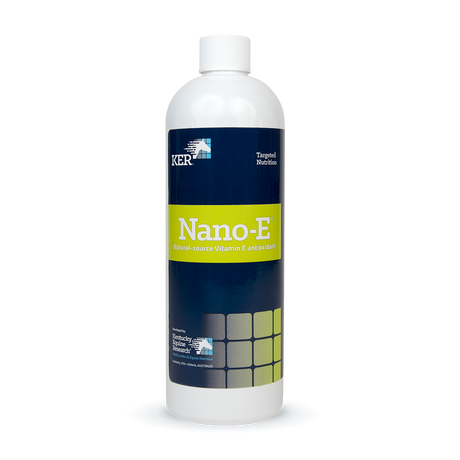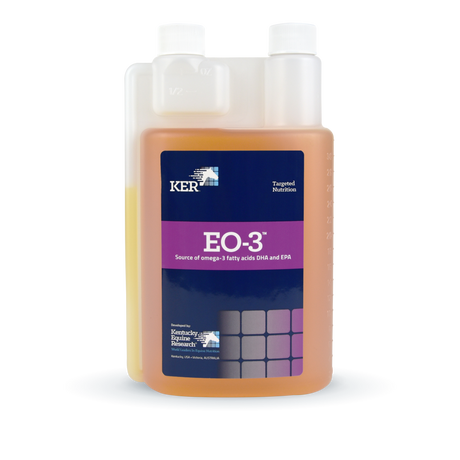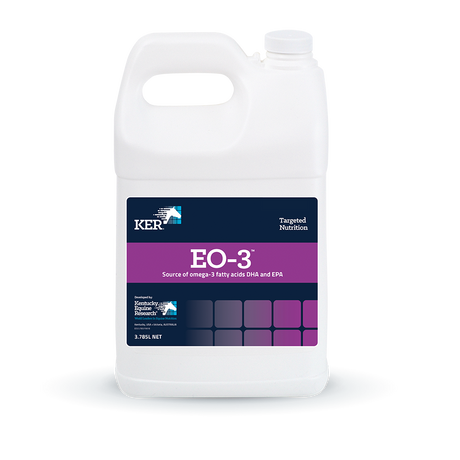
TYING-UP
TYING-UP
Tying-up is a generic term commonly used to describe muscle disease in performance horses. Other terms often used interchangeably with tying-up include exertional rhabdomyolysis, azoturia, and Monday morning sickness.
Classically, tying-up occurs after 15 to 30 minutes of exercise. Horses lose impulsion, develop a stiff, stilted gait, and may pause and stretch out as if to urinate or paw the ground. If pushed to continue exercise, horses sweat excessively, develop a high respiratory rate, and then upon standing become locked in place, unable to walk forward due to painful muscle contractures largely involving the back and hindquarters.
In addition to clinical signs, horses that tie-up will have moderate to marked elevations in blood serum levels of muscle proteins and enzymes including myoglobin, creatine kinase (CK), lactate dehydrogenase (LDH), and aspartate aminotransferase (AST). Such elevations indicate muscle cell damage and are considered a diagnostic tool to detect tying-up.
While acute signs of muscle pain and cramping are similar among horses, the causes of tying-up are varied. The incorporation of the muscle biopsy technique into clinical practice over the last 20 years and the more recent use of genome mapping have served to enhance the accuracy of diagnosis of muscle disease in individual horses and has allowed for the development of DNA-based tests for some muscle disorders in horses. Studies have now defined the breeds affected with these disorders and in many cases the prevalence of the disorders within breeds.
Initial classification of tying-up is now based on frequency of the disease symptoms following exercise. Horses that tie-up only a few times in their lifetime are classified as “sporadic,” while those horses that tie-up on a repeated basis are termed “chronic.”
Sporadic Tying-Up
Many horses experience some muscle soreness and strain associated with exercise. These horses often are mistakenly thought to be suffering from a specific muscle disease. Inadequate warm-up, preexisting lameness, exercise to the point of fatigue, and insufficient training can result in muscle soreness and injury.
In horses that actually experience tying-up, muscle soreness is much more severe and is typically accompanied with elevated blood muscle enzymes and myoglobinuria (coffee-colored urine). This darkening of the urine is a result of the kidneys filtering myoglobin (a muscle protein) from blood, an indication of severe muscle damage. The most frequent causes of sporadic tying-up are exercise that exceeds a horse's level of training, electrolyte imbalances, hyperthermia, and strenuous exercise while suffering from a viral respiratory disease.
Horses consuming a high-grain diet appear to be more likely to develop tying-up than horses fed a low-grain or fat-supplemented diet. The grain itself may not be responsible for rhabdomyolysis; however, high starch intake may trigger rhabdomyolysis in horses with particular myopathies such as recurrent exertional rhabdomyolysis (RER) and polysacchaaride storage myopathy (PSSM). Electrolyte depletion in horses can occur due to dietary deficiency and losses in sweat with strenuous exercise. Sodium, potassium, magnesium, and calcium play key roles in muscle fiber contractility.
Another proposed cause of sporadic tying-up is the increased generation of free radicals from oxidative metabolism associated with exercise. Selenium and vitamin E scavenge free radicals and prevent lipid peroxidation of cell membranes. Primary selenium deficiency is common in young animals living in areas with selenium-deficient soil; however, it has been demonstrated as a cause of exertional rhabdomyolysis. Vitamin E deficiency is also being seen more frequently as a greater proportion of horses are managed on cured forages (hay) with limited or no access to pasture grazing.
Sound management practices and training may help prevent tying-up. Learning not to overexert unfit horses and remembering to fortify the diet with salt on a daily basis as well as electrolytes prior to heavy sweat loss are logical strategies. Adjusting the amount of grain fed to satisfy the energy needs of the horse is also tremendously important. Feeding concentrates fortified with fat and necessary antioxidant vitamins and minerals will provide energy while supplying the building blocks to protect muscle tissue. The combination of these strategies will often prevent healthy horses from having another bout of tying-up. In areas where the soil is deficient in selenium, a selenium and vitamin E supplement may improve muscle health.
Chronic Tying-Up
When horses have repeated episodes of tying-up, the disease is considered chronic. Members of many different breeds of horses have been reported to have chronic bouts of tying-up, including Quarter Horses, Thoroughbreds, Standardbreds, Paints, Morgans, Arabians, and various breeds of draft and warmblood horses.
There are now four specific causes of chronic tying-up that have been recognized, though there are likely many more underlying causes yet to be discovered. These include recurrent RER, PSSM type 1 and type 2, and malignant hyperthermia.
Recurrent exertional rhabdomyolysis (RER) is an inherited condition that involves abnormal intracellular calcium regulation during muscle contraction. Horses with RER suffer from painful muscle cramping when they exercise. This form of tying-up is sometimes triggered by excitement or stress, and is seen somewhat more often in young, nervous fillies in race training. Horses with RER are often training and exercising at an intense level, so they usually have a need for more calories than can be supplied by the fats and forage portion of the diet. At the same time, high grain intakes are associated with tying-up. For that reason, they do best when managed on a feed with high caloric density that derives the majority of its calories from fat and fermentable fiber sources, as these often aid in avoiding excitability that can occur with significant intake of nonstructural carbohydrates.
Polysaccharide storage myopathy (PSSM) is seen in horses with Quarter Horse breeding, and also in some draft and warmblood breeds. It is characterized by abnormal glycogen accumulation in muscle tissue caused by a hypersensitivity to insulin, elevated blood glucose, and excessive activity of glycogen synthase (one of the enzymes that produces glycogen). Physical problems range from muscle quivering and cramping to sudden collapse. Horses with PSSM are best managed on a program similar to that of RER horses, with energy and nutrients provided by a low-starch, high-fat feed. Other management techniques that are necessary include allowing free movement (turnout) as much as possible and incorporating daily exercise. Severely affected horses may need exercise introduced very gradually and slowly built up until they tolerate a normal level of activity.
Myofibrillar myopathy (MFM) The understanding of muscle disease in horses has broadened considerably over the last few decades. Researchers continue to discover nuances in muscle dysfunction, and one disease continues to gain recognition within the Warmblood and endurance communities: myofibrillar myopathy (MFM). Like those diagnosed with polysaccharide storage myopathy (PSSM), horses with MFM demonstrate exercise intolerance and occasional episodes of tying-up. Microscopic examination of muscle tissue reveals, however, that the underlying cause of MFM is much different than it is for PSSM. Rations for horses diagnosed with MFM should focus on providing high-quality protein and specific amino acids, which may support the regeneration of sarcomeres.
Which solution is right for your horse?
EO-3™ Omega-3 supplement. EO-3 is a rich source of omega-3 fatty acids DHA and EPA, compounds found to optimize the well-being of all horses, regardless of age or use. Specifically DHA and EPA supplementation has been shown to mediate inflammation as well as improve insulin sensitivity. Choose EO-3 to promote a more natural balance of omega-3 to omega-6 fatty acids in the body and the benefits this balance confers on systemic inflammatory response, immune function, and insulin sensitivity. Recommended for horses with pituitary pars intermedia dysfunction, metabolic syndrome, and any horse that is insulin resistant.
Nano-E® Nanodispersed, liquid natural-source vitamin E supplement. Nano-E provides a highly bioavailable natural (d-α-tocopherol), water soluble source of vitamin E to horses through a unique delivery system. Choose Nano-E to provide potent antioxidant support to horses with PSSM, EPSM, or RER, to provide optimal support of immune function in horses with Cushing’s disease, and to provide highly bioavailable vitamin E to horses that have limited access to pasture.
MFM Pellet™ Muscle recovery and repair. Use MFM Pellet to increase the amount of key amino acids and high-quality protein to protect the muscle from oxidative stress and rebuild damaged muscle fibers in horses with myofibrillar myopathy.
Nano-Q10™ Antioxidant for horses in training. Coenzyme Q10 is a powerful antioxidant that improves aerobic energy generation while protecting against exercise-induced muscle damage. Nano-Q10™ is a rapidly absorbed source of coenzyme Q10 that is three times more bioavailable than the powdered crystalline form.
RE-LEVE® Veterinarian-recommended feed for horses requiring a low-starch diet. RE-LEVE, the first research-based low-starch feed, is beneficial for horses prone to the following muscular disorders and metabolic syndromes: polysaccharide storage myopathy (PSSM or EPSM), laminitis (founder), recurrent exertional rhabdomyolysis (RER). (Please note, discounts and promotions do not apply to this product.)
- $35.00Unit price /Unavailable







